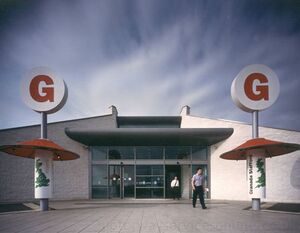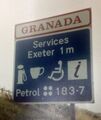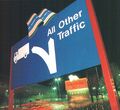Granada
| Locations: | up to 45 |
| Introduced: | 1964 |
| Removed: | 2001 |
| Predecessors: | Pavilion, Taverna, Mobil, Kenning Motor Group |
| Successors: | Moto, First |
| Head office address: | Granada Motorway Services Ltd M1 Service Area Toddington Bedfordshire LU5 6HR |
Granada was a mammoth business with many subsidiaries operating in many industries. They are perhaps remembered in the UK for operating the North of England ITV franchise, as part of a media business which saw them run cinemas and bingo halls, TV studios, publishers, TV rental shops and theme parks. In 1999, they boasted: "everyone in the UK has at least one contact with Granada every day".
Of interest to us is Granada Motorway Services ("GMS"), a business which frequently tested regulators and pioneered new ideas, eventually becoming the UK's largest motorway services operator. They expanded to create a large network of restaurants and hotels which was known internally as Granada Roadside. They took a very different approach to that of their biggest rival, Trusthouse Forte, but the two both became giants by chewing at their competitors.
The Granada name is often remembered as being a product of northern England. While this was true for its media business, and they did own both England and Scotland's most northern motorway service areas, they also built the most southern motorway site at Exeter. Granada Roadside was managed from Toddington in Bedfordshire, its first motorway service area, and the original business was based in Dover.
Company History
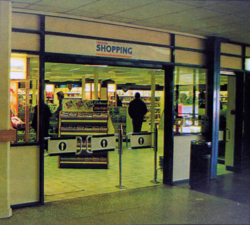
In the 1960s, companies with hospitality arms including cinemas and theatres were encouraged to enter the motorway services industry, as the Ministry believed they had the experience to provide a high-quality service. Granada said that their experience with a diverse range of theatres would help them cater for motorists.
Granada entered the motorway business in 1962, with a bid for Toddington which was eventually successful. While all the other motorway service areas believed the key to success was to provide an excellent experience for the wealthy families who would be using the motorway, Granada's intention was to cater for the masses. Garish advertising and noisy slot machines helped them pay the bills, while a range of seedy and tacky products for sale in the shop set the tone for what customers could expect.
By the time Toddington opened in 1964, the luxury dining most people associate with early motorway service areas was already losing its novelty. Granada included grill restaurants as they felt they ought to, but they were already thinking about how to better suit the public.
In the 1970s they created a simple café for everyone, called Granada Chef. It used noisy conveyor belts and had tea machines stood alongside a cheery red-and-white backdrop, and initially had a policy of refusing to cook eggs after 11:30am. Dairy issues aside, their free-flow catering was widely regarded as offering a much better service than any other operator - probably because it didn't claim to be anything special so couldn't disappoint.
Meanwhile, Granada were the first motorway operator to introduce entirely self-service petrol stations. They provided coffee shops for people not wanting a meal. All-in-all, they were very successful in getting as many people through as efficiently as possible.
Although other operators soon followed Granada's lead, none took it as far as they did. Granada would purchase service areas such as Mecca Village and remove all the frills. This cost-cutting eventually resulted in a poor reputation, which Granada tried to address in the 1990s with better building design and new facilities.
Having campaigned for many years to get the government to loosen the regulations affecting service areas, in the late 1990s Granada were able to turn many of their service areas into mini shopping centres, filled with High Street Brand.
Reputation
Government Highway Services division, 1966.
Granada's unusual approach soon raised eyebrows at the Ministry.
Government policy at the time was to build one service area, and when it became full, to get another company to build one further along the road. Granada's strategy was to propose unnecessarily large restaurants that would never be full and therefore never receive a competitor. The Ministry spotted the pattern and started refusing Granada's plans, especially as they were frustrated with Granada's complaints that their existing restaurants were unprofitable; "optimistic" was their summary of Granada's building style.
Granada broke regulations by selling gramophone records and merchandise branded "Granadaland", by writing their logo all over their buildings and fuel pumps, by promoting their ITV franchise, and they resisted requests for them to follow the rules. Their 'welcome' sign looked like something from Las Vegas. The wider Granada business would ultimately go on to own several visitor attractions and inspectors felt they were treating their service stations in the same way. They wanted to build a leather goods shop which at the time was regarded as revolutionary.
In fact, throughout the 1960s staff at the Ministry of Transport frequently complained that the only time Granada appeared to acknowledge any contracts, policies, commitments or agreed timescales was when they were asking for an exemption. They would also interfere and interrupt the Ministry's construction work. Relations got so bad Granada nearly had the right to operate Heston taken away from them, while in 1970 Granada pulled out of their contract to build Birch and threatened to stop bidding after Leigh Delamere.
With other operators the Ministry would try to work with them to address issues as they arose, but with Granada they become so frustrated they resolved to follow every policy to the letter. Granada were pushing for a "bare-wall, utility standard pattern" of restaurants that the Ministry wanted to resist, somewhat unsuccessfully.
It wasn't just the Ministry who were fed up. Charles Forte claimed that Granada had contacted him for advice on running service areas in August 1963, and he lamented inexperienced firms like them beating him to contracts.
Directors from Granada made an application to build Scratchwood services under the name Grand Metropolitan Motorway Services. Despite it being a good bid, they lost because of Granada's poor reputation.
Initial Expansion
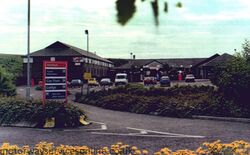
Granada's first major expansion came with their purchase of Taverna in 1973. Although Granada were keen to take over most of Taverna's sites, their biggest competitor at the time had been forbidden from taking over any more anyway. This purchase meant Granada was now the largest operator, and they had "learnt a lot from their past mistakes".
Documents about the takeover give us detail about Granada's service areas at the time. Apparently their architecture, some of which would have been nearly 10 years old, was "dull and workmanlike". They had been providing good maintenance but a poor atmosphere. Their principle of providing basic but acceptable catering had worked for them; a steak & kidney pie and coffee in their café cost £1.32 in 1977 (around £8 in 2025). In 1978 they were praised for making "a commendable effort" to improve food quality with standardisation.
A rivalry with fellow hospitality giant Trusthouse Forte developed in the late 1980s. Both wanted a network of budget hotels with adjacent family-restaurants, and wanted to build as many of them as possible. Even if it didn't look profitable, Granada would build so that Forte couldn't get there first. They briefly used the name Granada Waysider for some of their A-road service areas, and launched an upmarket hotel with cocktail bar at Alfreton.
Granada said that they wanted to cater for every road user, whereas their rival was focused on car drivers. Some HGV drivers told reporters that Granada were the only operator who cared about them. This was despite Granada being the first to close all their transport cafés, instead providing a dedicated seating area for HGV drivers within the public restaurant area.
Junior Health Minister Edwina Currie MP, 1988
Granada's new restaurant Country Kitchen was a considered effort to take the customer's focus as far away from motorways as possible. A tree-shaped children's play area was provided where space allowed. As the focus of their service stations moved towards catering, Granada would sub-let their repair bays to outside contractors. As a result Granada tended to remove their name from their petrol stations, and used Mobil instead.
In 1986, Granada's parent company resisted a takeover from Rank's.
Motorway Monopoly
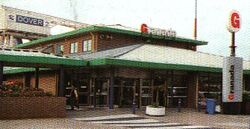
Good news for Granada continued into the 1990s. They bought eight sites from Pavilion for £125million in 1995 (around £252million in 2025), again making them the biggest motorway operator. Forte's Welcome Break were said to be interested in Pavilion, but they backed off because they didn't want to be investigated by the Monopolies and Mergers Commission. Granada had to agree to sell two of their own sites (creating First in April 1996), which they said was "not a surprise".
By this point, Esso and Mobil had started designing new motorway service areas, to ensure they had a grip on the fuel market. Granada's close relationship with both of those companies meant that they were frequently asked to run the main buildings for them, allowing Granada to expand even faster.
In November 1995, Granada went public with their secret operation to takeover The Forte Group. The hostile takeover was completed in January 1996, and from a roadside perspective Granada now owned their competitors Welcome Break, roadside restaurants Little Chef and Happy Eater, French operator Côté France and budget hotel chain Travelodge. Granada also acquired a number of outstanding planning applications, which they would carry forward themselves.
Upon buying Welcome Break, Granada described the company's original concepts as "still looking good", but that they "have not been kept up to date". Granada wanted to focus on popular brands, add fast food to all their service areas and to make a much-doubted £500million from the deal, which would be around £1billion in 2025. Just months after buying them, Granada raised the prices at all of their service areas given that they now owned over 75% of the motorway market. They did make their £500million.
Another of Granada's chosen brands was Little Chef. The new subsidiary Granada Roadside intensively expanded it, by converting all the Happy Eater and adding Little Chefs and Burger Kings to almost all their service areas, including the Welcome Breaks. Travelodge was another of Granada's favourite parts of the acquisition, and this replaced all their own lodges.
Away from the motorways, Granada were now heavily involved with many hospitality contracts, operating restaurants at airports, railway stations, ferry ports and on ferries, some of which was done under the Little Chef name. Staff could be moved across the business, for example Granada's restaurants at Stansted Airport could call on staff at South Mimms services to help out.
In July 1996, the Monopolies and Mergers Commission ruled that Granada Motorway Services needed to sell Welcome Break's motorway sites. In March 1997 they sold the Welcome Break brand to Investcorp for £476million (around £1billion in 2025), having run both Welcome Break and its own service areas for nearly two years. The wording of the ruling meant Granada could keep Welcome Break's A-road service areas, which they did, but Granada's brands had to be removed from the sold sites.
Côté France was sold to Italy's Autogrill in December 1997, for £83million (around £161million in 2025).
A New Direction
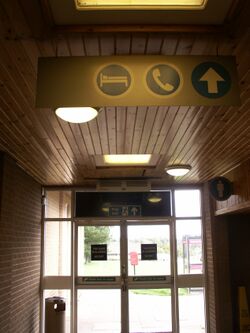
Despite their monopoly and their reputation, the 1990s was also a time of great investment from Granada. The evolution in the quality of landscaping from Thurrock (opened 1992), to Cherwell Valley (opened 1994) and Stafford (opened 1996) is clear. They combined this with a bright and airy food court to create Donington Park (opened 1999).
Customer surveys were held often, and Granada claimed the results were largely positive. An electronic loyalty card was introduced in 1994, which could be redeemed in Granada shops or for Esso Tiger Tokens.
Despite this, Granada were worried about the number of drivers choosing to drive by. They brought in a number of partners to improve their brand, including graphic designers Pentagram, retail advisors 20/20 and industry advice from former Forte consultants Wolff Olins. After customer surveys, a design process of "wit and stamina", a new coffee bar concept and lessons learned from other developments, the focus was all on developing Stafford.
Pentagram said Granada's styling "lacked consistency and consideration". They suggested replacing carpets with polished wood, making the facilities larger, and, most impressively, appointing staff to welcome customers and to hand them ashtrays. They created the new "red G" and circular identity which were rolled out nationwide in September 1996, and evidence of it can still be found today. Staff were given circular name badges width red drop caps. Circles were everything, and everything was focused on a coherent image.
The new concept wanted to combine "in-house enterprise" with "ready-made reputations". The Brand Standards Manager insisted that each entrance had a network map on the left, and a list of facilities on the right. Little Chef and Burger King were treated as the top tier brands, and were advertised all around, with their logos being placed on stripey awning and on rotating lollipop signs that created a sense of wonder. Granada explained: "the red G stands for quality, service and value" (none of which begin with 'G'), and they proclaimed that it was "Britain's favourite motorway sign".
They divided their clientele into "families", "commuters" and "businesses". For businesses, new business centres were created. For commuters, new concept drawings show plans for a new style of petrol station covered in Granada branding, with facilities inside from Pizza Hut, Burger King, La Brioche Doree, Kenco, Dunkin' Donuts, Blimpie and Fresh Express. Granada believed the future of all roadside catering lay in brand names. This particular idea was inspired by the Swedish brand Mango.
True to form, Granada managed to cause a stir with their new brand, by failing to follow planning regulations before displaying their new logos resulting in significant charges from several local councils. An in-house radio station 'Granada FM' ('GFM') was introduced in partnership with RBS, but staff had been known to turn it off as they didn't like it.
Further changes came in two phases. Firstly, Granada wanted to ensure their service areas offered a large food court, where Fresh Express, Little Chef, Harry Ramsden's and Burger King could be found, with an emphasis on choice and new interiors created by BDG McColl. Secondly, they began to introduce large shopping areas to their sites, offering a long list of town centre names in what Granada called their "town". These were based on BAA's airport terminals. Granada reported that initially some brands were reluctant to work with them, but changed their minds. The initial shopping partners were Superdrug, Thorntons, Sock Shop, Clinton Cards and Tandy Express, with Tie Rack, Ladbrokes and Boots also on the list.
They then worked with Littlewoods to introduce internet facilities, trialled Motorpoint online car showrooms and mini-cinemas for kids. Inevitably, they clashed with the Highways Agency and local councils over how to read the regulations surrounding service station shopping areas.
Granada also worked with the Department for Transport to look into combining service stations with transport interchanges, while some service areas gained cordoned-off workspaces with a dedicated reception area. Their old ways never left them: they started to use a number of their car parks for pallet trading, which prompted the Highways Agency to say "we completely deplore it". They also began to upset regular customers with strict and steep parking charges.
Sudden Ending
Granada, 1999
The distinctive branding, and their long-running TV franchise, meant the Granada name was iconic to many people. Despite this, and despite all the investment, it was troubled. Granada's motorway and A-road service areas required more investment to remain competitive. Investors feared their hotels may not be sustainable. Meanwhile, the media business was heavily burdened by its involvement in the failing ONdigital project. On the motorways, Granada sought to extract as much profit as it could, with Little Chef being treated as a cash cow.
Granada had already hinted that things would change. They announced in early 2000 that their 'red G' identity was "under review", and likely to be removed in the following two years, although they added that the name wasn't going to be changing. With not many options for new service areas, Granada wanted to focus on attracting commuters to their existing sites instead.
The wider Granada group had different plans, and on 27 July 2000 the company merged with the Compass Group. The plan was to completely separate its media and hospitality arms, which formally happened in February 2001 with the Compass brand taking responsibility for all of Granada's hospitality interests under subsidiaries including 'Compass Roadside'. The merged 'Granada Compass' could have just sold its media business, but would have faced a significant capital gains tax bill if it had. Granada Roadside ended for financial reasons.
Now Granada were no longer involved, Compass worked with The Point, BDG McColl and Fallon to create Moto. The new name was launched on 22 May 2001 and it promised a "a better, continental-feeling service". Ironically they wanted to achieve this by ditching the brand named after a Spanish city.
Brand Partners
These names did not all appear side by side. However, some of the names Granada's motorway division could be associated with can be seen below:
Catering: Café Nescafé, Granada Chef, Granada Restaurant, Coffee Bar, Country Kitchen Restaurant, Harry Ramsden's, Little Chef, Pizza Hut, Rock Island Diner, Burger King, Happy Eater, AJ's, La Brioche Doree, Burger Express, Perfect Pizza, Granada 2Go, Friendly's
Shops: Retail Store, Granada Shopping, The Shop, Boots, The Body Shop, Halfords, Birthdays, Claire's Accessories, Knickerbox, Sock Shop, Ladbrokes, Scoop, Thorntons, Superdrug, Tandy Express, Clinton Cards, Motorpoint, Early Learning Centre, BHS Express, Sketchley, Tie Rack, holiday booking
Main Amenities: Contemplation Room, Trucker's Lounge, Business Rooms, Granada Amusements, G-Scape
Hotels: Travelodge, Granada Lodge
Fuel: Esso, Mobil
In addition to those listed above, in 1999 Granada published a secret list of "expressions of interest": retail chains who had said they would want to open a store at a Granada service area. These were: Thomas Cook, Salisbury's, SF Codys, WHSmith, Holland & Barrett, Disney, Warner Bros, Wax Lyrical, Dixon, Monsoon, The Perfume Shop, JD Sport, Whittards, Sunglass Hut and Vision Express.
Brand Identity
For most of their run, Granada's catering and media divisions used a red logo in block capitals. On publications about service areas, this was later joined by a road-shaped flag and a description of what they did. Blue text was used on many of their corporate signs.
Their 1980s logo used the font Clarendon Bold.
Granada's final logo, introduced in 1996, was dubbed the "red G" and marked an associated change in branding across the entire estate. The black text (on publications) or white text (on buildings) with a red G was used everywhere. The red G itself was created by John McConnell, and the font it utilised was Franklin Gothic Heavy.
Slogans have included "fast, friendly service", "the better motorway services" and, in their final year, "supporting you every mile of the way".
-
Red text on a building in the 1960s.
-
Granada's logo on a red background.
-
By the 1980s, the colours on their logo were inverted, with these 'welcome' signs being common.
-
The red text logo in use (1980s).
-
Red and blue being used together on A-road direction signs from the late 1980s.
-
The early 1990s logo. The flag was used as an emblem on buildings.
-
The flag being used on a short-lived style of corporate direction sign. A welcome sign is behind it.
-
An example of the red and blue working together inside.
-
The final, 'red G' graphic, used from 1996.
-
The circles and 'G' on the sign which formed the entrance to all Granada sites.
-
The infamous corporate signage scheme which was introduced in 1996.
Even though the Granada name was retired from hospitality in 2001, it can still be found hidden away in many service areas. Mostly it appears on health and safety notices, emergency information and internal documents.
Locations
See also: Map of Granada service areas
The following service areas were operated by Granada:
- Birch (M62)
- Blyth (A1(M)/A1)
- Burton-in-Kendal (M6)
- Cardiff West (M4)
- Cherwell Valley (M40/A43)
- Chieveley (Newbury) (M4/A34)
- Doncaster (North) (M18/M180)
- Donington Park (M1/A42/A50)
- Exeter (M5)
- Ferrybridge (M62/A1)
- Frankley (M5)
- Heston (M4)
- Hilton Park (Birmingham North) (M6)
- Kinross (M90)
- Knutsford (M6)
- Lancaster (Forton) (M6)
- Leigh Delamere (M4)
- Magor (M4)
- Medway (M2)
- Pease Pottage (M23/A23)
- Reading (M4)
- Severn View (M48)
- Southwaite (M6)
- Stafford (M6)
- Stirling (M9/M80)
- Swansea (M4)
- Tamworth (M42/A5)
- Thurrock (M25/A13/A282)
- Toddington (M1)
- Trowell (M1)
- Washington-Birtley (A1(M))
- Woolley Edge (M1)
Smaller Services
- Alfreton Waysider (A38)
- Dover Port
- Grantham (Colsterworth) (A1)
- Grantham North (A1)
- Lymm (M6/M56)
- Leicester (Markfield) (A50/M1)
- Monmouth (A40)
- Musselburgh Waysider (A1/A720)
- Oxford (Peartree) (A34/A40/A44)
- Saltash Waysider (A38)
- Scotch Corner (A1/A66)
- Sheffield (A57)
- Sutton Scotney (A34)
- Tiverton (M5)
- Warminster (A36)
Unbuilt Services
The following service areas were planned by Granada but they were never built:
- Basingstoke (M3)
- Birch (M62) - eventually bought by them
- Bothwell (M74)
- Bramham Crossroads (A1(M))
- Bridgwater - site adjacent to existing service area (M5)
- Clacket Lane (M25)
- Corley (M6)
- Hamilton (M74)
- Kempshott (M3)
- Forton (M6) - eventually bought by them
- Leigh Delamere (M4) - eventually bought by them
- Leicester Forest East (M1)
- Maidenhead (M4/A308(M)/A404(M))
- Okehampton - in 1990 Granada had planning permission for a site "on a hill" on the A30. It hasn't yet been found.
- Pucklechurch (M4)
- Stafford - a site opposite the existing service area (M6)
